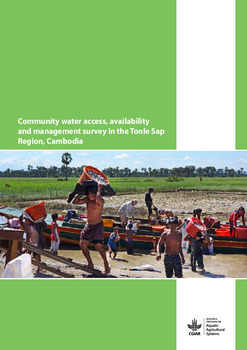Community water access, availability and management in the Tonle Sap region, Cambodia
Abstract
During the rollout of CGIAR Research Program on Aquatic Agricultural Systems (AAS) in Tonle Sap in 2013, water management was highlighted as one of the key development challenges. With limited capacity to regulate water, the situation oscillates between too much water in the wet season and too little water in the dry season. Access to and availability of water were seen by local communities as major limitations for aquatic and agricultural production, impacting on functions that include the lake fishery, intensive (dry season) rice crops, recession rice, rainfed rice and floating rice by the lakeside. For both fish and rice production, water and water management are determined principally by the natural flooding of the Tonle Sap Lake. This study is based on a community survey on water access, availability and management and was conceived out of the AAS consultation process and was developed to help identify existing practices in water use and management, as well as best practices where lessons can be learned and promising activities scaled out to other communities. The community survey also aims to understand, identify and analyze constraints and opportunities related to water, and includes a gender perspective to better understand the role of women in water management and use

